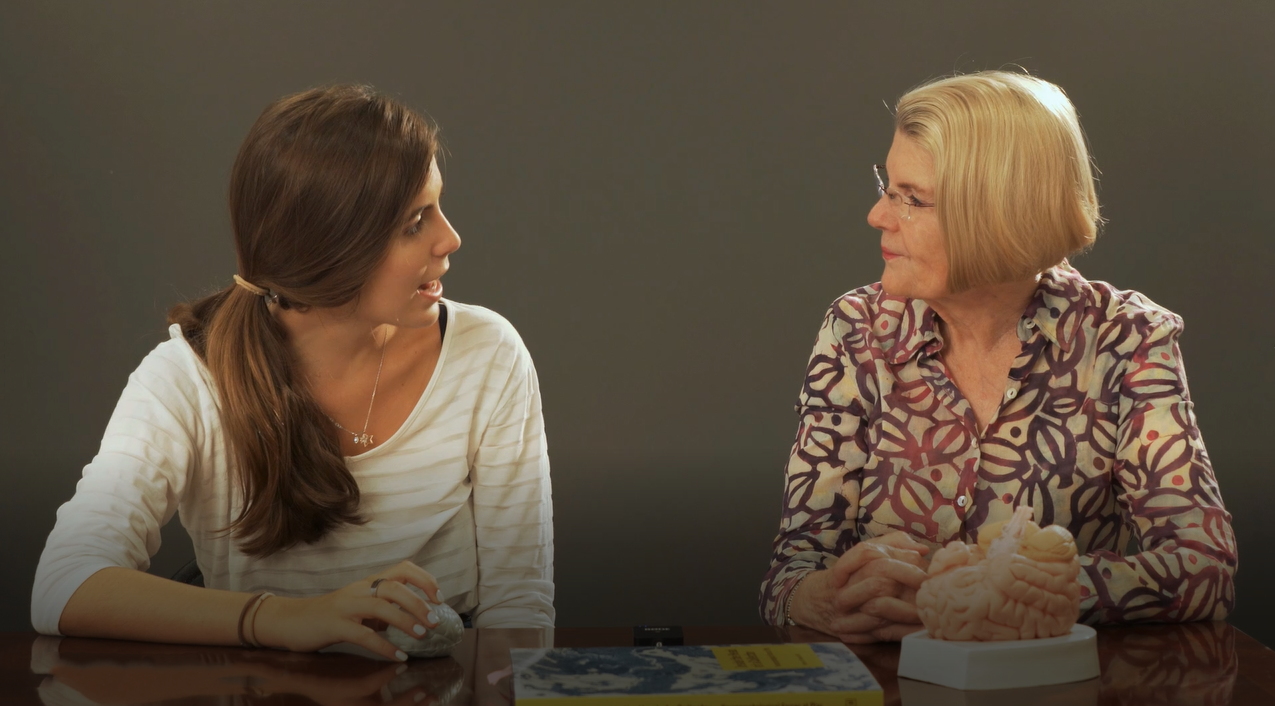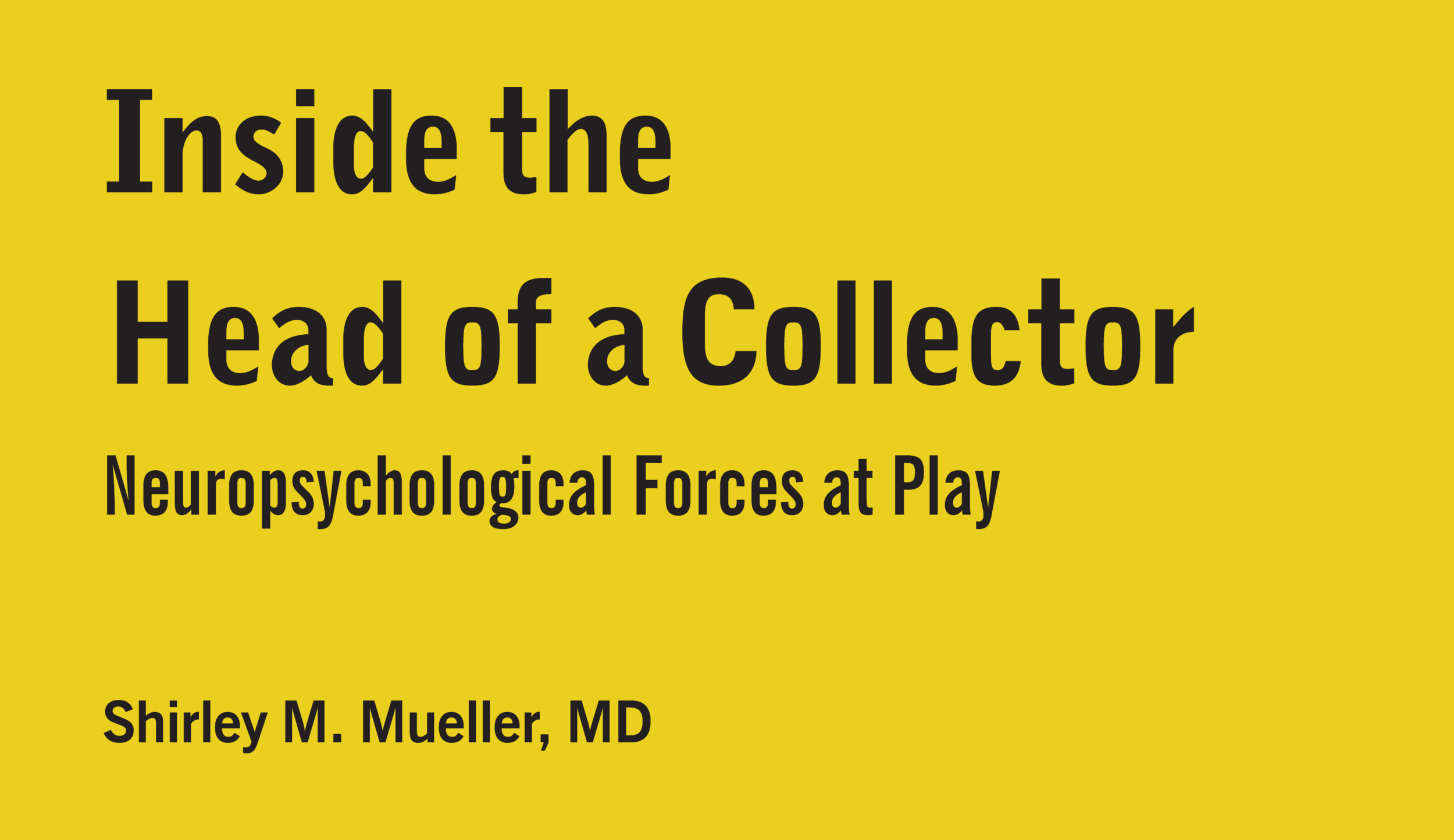
The Neuropsychology of an Art Collector:
Inside the Collector Brain
Shirley M. Mueller, why do collectors collect Art?
The reason we collect art is simple. It makes us happy. In this faraway place, apart from the rest of our lives, we can imagine. This is different than when we are involved in the routine aspects of living; then, we can reliably predict much of what will happen. With art collecting, we don’t know what to expect. It can take us anywhere. And, we can easily anticipate a whole new world of excitement.
Along with these expectations comes a quest for knowledge far beyond just reading. It broadens into joining associations related to our art collecting specialty, meeting wonderful people, attending conferences, going on trips with like-minded groups, and individually pursuing destinations of interest. Finally, it can take over life itself. What a pleasure. Collecting art isn’t a job. Collecting art isn’t a hobby. It’s better. It’s a passion.
The advantage of this book is that it encompasses a wide swath including collecting art, collecting and collections, collectors and collecting, art collectors and connoisseurs, art curators, the psychology of collecting, the neuropsychology of collecting, neuropsychology, and neuroscience. There is something for anyone who loves art, and, especially those who collect art. It facilitates the reader’s journey in understanding her or his collecting behavior using new science.
Inside the Head of a Collector:
Neuropsychological Forces at Play
Part 1: Pleasure and Pain
Pair of Chinese export porcelain underglaze blue tea caddies, c. 1640.
BEHAVIORAL ECONOMICS incorporates insights from psychology and other social sciences into the study of monetary behavior, including collecting.
Part 2: Enhancing Pleasure Through Understanding Ourselves
Chinese export porcelain underglaze blue Parasol Ladies plate (Cornelis Pronk design), 1737–40.
NEUROECONOMICS is the study of the biological foundation of economic decision-making, of which collecting is a subset.
Part 3: Collector Experiences
Installation photo from “The Luxury of Tea and Coffee, Chinese Export Porcelain: Highlights from the Shirley M. Mueller Collection,” 2011–17, at the Indianapolis Museum of Art at Newfields.
To invest in art simply because we love it—with secondary motivators such as pride, intellectual satisfaction, or a connection to history—is one thing. To invest in it purely because money is the motivating factor is another.
Helpful drawings, illustrations and scientific moments
Among the areas of the emotional brain which are important in decision-making are the pleasure center (nucleus accumbens), the area responsive to price (insula), and the fear sensor (amygdala). Though these areas have interrelated connections and each has individual functions, they participate importantly together in determining choice.
Reviews & Accolades
What makes collectors collect? Attempts to answer this question have often appeared in this publication and in others. A new undertaking in this realm comes from author Shirley Muller, who is all at once a practicing neurologist, a financial advisor, and a collector of Chinese export porcelain. Mueller gives us examples for her own collecting adventures in which authentic and inauthentic porcelains are shown side-by-side with accompanying photos of brain imaging and scientific explanations. To answer the above question, some of the reasons people collect are (not necessarily in this order) intellectual reward, social interaction, enjoyment of possession, and thrill of the hunt. Also, because it makes us happy!
There are regions in the brain that respond to pleasure, anticipation, pain, and so on, and these can be identified to some extent by functional magnetic resonance imaging (fMR). Mueller, with her scientific background, has a particular view of the mechanics of desire and satisfaction, which include the neurological evidence of what goes on when a collector is at work. But that is not to say that this book is a dry, clinical treatise on what neurons do when confronted with a famille rose teapot. Mueller has the passion of a collector, and she fully understands the allure and pitfalls of the hunt.
Besides being full of illustrations of fine porcelain, Mueller's book also shares numerous anecdotes. For example: “I walked into an art gallery on Madison Ave in New York. I meant to browse, look at merchandise, perhaps learn a thing or two and leave. What I found was a Winslow Homer painting….” Which of us has not had a moment like this? Mueller takes us through the gamut, with chapters on novelty and discovery, fakes, damage and loss, bargains, collecting gone awry (some call it hoarding), art as an investment, and collection dispersal. She reveals the motivations underlying what happens when we see that teapot or painting. Striking an adroit balance between the jargon of behavioral science and the talk of antiques, this book comes out in the end being insightful, informative, and entertaining.
— Maine Antique Digest MAD Collector Review January 2020
“Dr. Shirley Mueller’s book Inside the Head of a Collector is a “must read” for all collectors. She has used her professional skills to analyse a collector’s thought process, and I must congratulate her on her research and conclusions based on her experience in collecting mainly Chinese export porcelain. This book brings the excitement, the commitment and the fears of collecting in one volume and looks at collecting from an emotional and psychological angle which collectors, museum professionals, dealers and others will find fascinating just as I did.”
— Anthony du Boulay, Fellow of the Society of Antiquarians, is the author of multiple books on the decorative arts including Chinese export porcelain
Book Review: Arts of Asia
“Why do we collectors do what we do! Inside the Head of a Collector answers that question. Dr. Shirley Mueller’s new book is unlike any other I have ever read. In it she draws upon her unique background in neurology, economics, and art collecting to tell us both about her wonderful porcelains AND about how a collector’s brain responds to art. The rush of adrenaline one has when you spot something great for your collection . . . The agony of disappointment when your beloved object turns out to be a fake!
I have had the pleasure of working with Dr. Mueller as a friend, curator and trustee of the Indianapolis Museum of Art at Newfields. Her keen mind and passion for art makes this book a pleasure to read.”
— Charles L. Venable, PhD, is the Director of the Indianapolis Museum of Art at Newfields: A Place for Nature & the Arts. He is the author of multiple books and articles on the decorative arts.
“Inside the Head of a Collector is a unique and remarkable book, which is part behavioral economics and part neuroscience, intertwined with personal anecdotes. Dr. Shirley Mueller’s passion for Chinese porcelain, experience as a collector, and knowledge as a neurologist animate this beautifully illustrated and clearly written book.
The collector interested in the neuropsychology of decision making, the scientist interested in the practice of collecting art, and the museum visitor interested in a behind-the-scene insight into exhibits will want to read this book.”
— Anjan Chatterjee, MD, Fellow of the American Academy of Neurology, is Elliott Professor and Chief of Neurology, Pennsylvania Hospital and author of The Aesthetic Brain: How We Evolved to Desire Beauty and Enjoy Art
“Mueller is a prominent collector and scholar of Chinese export porcelain, as well as a physician board-certified in Neurology and Psychiatry. This intersection of expertise led her to explore her own intentions while collecting art and the applicability of those factors to a broader community of collectors. Her research provided the motivation for this book, a worthy acquisition for those who have felt the thrill of the hunt and the angst of the one that got away (or the one that was not quite right).
Collecting objects gives enormous pleasure to approximately 1/3 of the population, providing such benefits as intellectual stimulation, the excitement of the chase, and leaving a legacy. Alternatively, the same pursuit can engender pain by paying too much for an object or unknowingly buying a fake. In this three-part treatise, Mueller introduces new scientific research in neuro- and behavioral economics that delivers an objective way to enhance the positive aspects of collecting and minimize the negative. Her information is relevant not only for collectors but also for the museum staff who interact with collectors and the dealers of objects desired by collectors. The author beautifully blends art in science for the benefit of the reader and the case studies that accompany each section add real-world context to the discussion.”
— The Magazine of the Decorative Arts Trust, Winter 2019-2020
This summer Shirley M. Mueller, M.D. published her latest book, Inside the Head of a Collector: Neuropsychological Forces at Play. Readers of Fine Art Connoisseur may recall Mueller’s articles in 2010 and 2011 about her passion for collecting Chinese export porcelain and the scientific aspects of her decision making. Since then, she has been researching this 192-page book, published by Lucia Marquand and available via Amazon, and in 2017 she guest-curated an exhibition for the Indianapolis Museum of Art, Elegance from the East: New Insights into Old Porcelain. In that show, she combined export porcelain with concepts from neuroscience to make historical objects personally relevant to visitors. Mueller’s new book provides scientific answers to the question “why do collectors do what they do?” by drawing upon her unique background in neurology, economics, and art collecting. She analyzes, for example, the rush of adrenaline we feel when we spot a find, or our agony when it turns out to be a fake. By analyzing her own experiences and illustrating objects in her collection, Mueller clarifies why collecting offers intellectual stimulation, the thrill of the chase, and satisfaction through creation of a legacy.
— Fine Art Connoisseur, September 2019
Shirley M. Mueller, MD
Shirley M. Mueller, MD is an internationally known collector and scholar of Chinese export porcelain, as well as a physician board-certified in Neurology and Psychiatry. This latter expertise led her to explore her own intentions while collecting art, which, she discovered, are applicable to all art collectors. This new understanding is the motivation for this book. Mueller not only lectures and publishes about the neuropsychology of the art collector; she also was guest curator for Elegance from the East: New Insights into Old Porcelain at the Indianapolis Museum of Art (now Newfields) in 2017. In this unique exhibit, she combined art represented by Chinese export porcelain with concepts from neuroscience to make historical objects personally relevant to visitors.
Connect with me online:

American Philatelic Society: Inside the Head of a Collector: Neuropsychological Forces at Work
Web3 with Dhee Dheeraj Shah interviews Shirley Mueller on why Collectors Collect: https://www.youtube.com/watch?v=xSx2Rn6bdsA
50 Of The Most Interesting And Unusual Collections People Have; interview excerpt from https://www.boredpanda.com/interesting-unique-collections/, July 2022
The Hobbies + Happiness Podcast Interview by Daniel Campbell and Jim Morgan, June 8, 2022
Available on Apple Podcasts
The Desire to Acquire: A Psychological Profile of the Serious Collector; A panel and discussion on why collectors collect sponsored by Apexart Nov. 13, 2021
Fun.ner Podcast Interview by Tim and Parker, October 6, 2021
Available on Fun.ner Website, Apple Podcasts, Spotify and Google Podcasts
The Stuff Dreams Are Made Of Podcast Interview by Dave Mandel and Ryan Condel September 30, 2021
Available on Apple Podcasts , Spotify , Google Podcasts
This Is Your Brain On Vinyl, and Other Tales From Obsessive Collecting in the Pandemic by Rich Juzwiak July 28, 2021
Smithsonian Magazine: Interview with Shirley M. Mueller, November 13, 2020
Antiques Trade Gazette: Interview with Shirley M. Mueller, January 2020
Antiques and the Arts Weekly: Interview with Shirley M. Mueller, December 17, 2019
Antique Collecting: Mind Games, Interview with Shirley M. Mueller, November 2019
Jewelry Journey Podcast: Interview with Shirley M. Mueller, October 14, 2019
Jewelry Journey Podcast: Interview with Shirley M. Mueller, November 23, 2020











